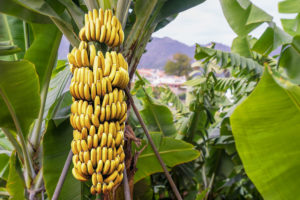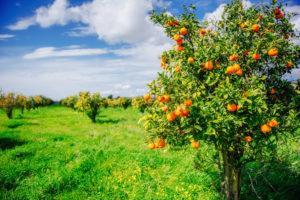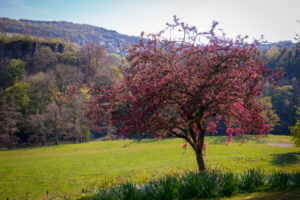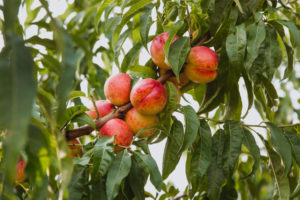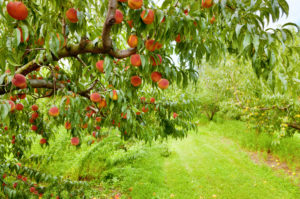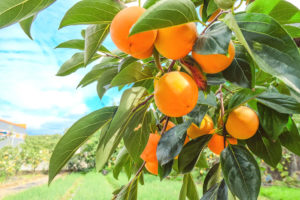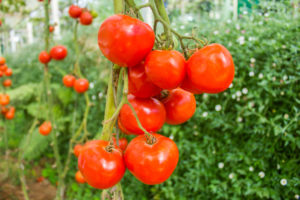22 Of The Very Best Australian Fruit Trees [Guide + Images]

Growing your own fruit trees to maturity is among the most rewarding of gardening activities. Whether you’re after a home orchard, a large shade tree that provides edible produce, or a more compact version that will brighten up your courtyard or balcony, the options are endless! And the best part? With a little patience, planning and TLC, you’ll be enjoying a yield of delicious, homegrown fruit before you know it!
The choice of fruit tree depends on your local climate, the size of the space available, and what type of tree you would like for your home in the long term. Here are some of the best Australian fruit trees (fruit trees that can be grown in Australia, rather than native fruit trees).
Apple tree
Apples grow best in cool, arid and temperate climates, and there is a wide variety of cultivars available for the home gardener. When planting, choose a sunny spot and fertile, well-drained soil. Winter is the ideal time for planting apples.
“Ballerina” apple trees, such as Flamenco or Bolero, have a column-like growing habit, which makes them ideal for smaller gardens. They also don’t need pruning, so they are very easy to care for. Less common varieties include Gravenstein, Cox Orange Pippin and Pomme de Neige. Cooking apple cultivars like Ballarat and Willie Sharpe are also worth considering for their spectacular size.
Apricot tree
Although apricots are generally thought of as being only suitable to grow in cool and warm temperate climates, some varieties will grow in subtropical areas. Trees should be planted in fertile, well-drained soil in winter when the plant is dormant. They need full sun to ripen, and allowing ample space around the tree will prevent a build-up of humidity and the possibility of fungal disease. Apricots are usually self-pollinating, however, it is recommended that two different varieties that will flower simultaneously are planted together.
In terms of watering, it should be done during hot summers and after cropping, so their buds develop well the following spring. They don’t like rain when they flower or when the fruit is close to maturity, so adding protection during downpours can prevent the fruit from splitting.
Pruning will allow branches to strengthen and thicken and should be done in February or March on a warm, dry day to avoid fungal infections from taking hold. Lowering the height of the tree will also deter bats and possums that prefer taller trees.
Apricots often fruit heavily one year and not the next, and this can be remedied to some extent by reducing the fruit when they are small and green in the “heavy” year. This is because if all the energy goes into the crop one year, it may not be available for the next.
In terms of varieties, the most reliable are Moorpark, Story, Trevatt and Riverbrite and all are excellent for drying. Varieties that are lovely eaten fresh are Earlicot, Blenheim, Katy and Supergold.
Avocado tree
Many people don’t realise, but technically, avocados are a fruit. For larger gardens, you can’t beat the popular varieties, Hass and Fuerte. For smaller gardens, the Wurtz is a dwarf cultivar that can be grown in a pot. Avocados are one of the easiest edible plants to grow from seed, and they produce fruit on their own, so you don’t need two avocado trees to produce fruit.
Avocados prefer warm, temperature and cool climates without frost. They grow best in full sun, away from strong winds, however, they are reasonably tough once established. They prefer fertile, deep, well-drained soil, should be watered regularly (but don’t overdo it) and can be pruned any time of the year.
Banana tree
In Australia, the Cavendish is the most popular commercially available banana, but in an attempt to prevent the spread of fungal diseases, it is now illegal to grow in home gardens. However, the smaller-fruiting Lady Finger is an ideal choice as they are easy to grow, and many people prefer their taste compared to the Cavendish. Bananas need a high-potassium fertiliser to help produce abundant fruit, and weeds should be kept away from the base of the plant to promote active growth.
Cherry tree
Some cherry trees can reach ten metres in height and require specific growing conditions, especially winter chill. However, there are a variety of cultivars and dwarf cherries that are much more flexible. Potted cherries are available year-round and can be planted at any time except the middle of summer. Bare-rooted trees should be planted in winter.
Cherries need humus-rich, well-drained soil, an open, sunny position and plenty of water in summer. Some cherries are self-fertile, while others require another cherry tree nearby for fertilisation. The other essential ingredient is bees, so grow flowers that attract bees into your garden in early spring, when cherries are in flower. Depending on the cultivar, the fruit can be harvested from early December to late February.
Citrus tree
These are some of the best small evergreen trees for Australian gardens, and plants in this genus produce limes, lemons, mandarins, oranges, kumquats and grapefruits, particularly if you choose a dwarf variety.
In terms of lemons, they include Lisbon, a heavy-cropping variety and Eureka, which prefers warmer climates. In terms of limes, one of the most unique Australian native fruit trees is the finger lime. Citrus trees prefer free-draining soils that are neutral to acidic. They also require regular watering and thrive with a layer of organic mulch.
Crabapple tree
Crabapples produce lots of small fruit that are generally too tart to eat but are a wonderful apple for making jelly. The best varieties for fruit production are Gorgeous and Golden Hornet.
One common complaint from home growers is that their apples fail to bear fruit after the tree’s blossoms wither. This is due to either late frost damaging the flowers or the apple not having another close flowering tree to cross-pollinate with. The second issue can be alleviated by planting a similar variety of apple nearby. The best all-round pollinator is the apple cultivar, Jonathan.
Fig tree
The edible fig is another tree that has varieties suitable for cold and warm temperate climates. Brown Turkey is ideal for warm winter areas, and the White Genoa for colder regions. Varieties such as Preston Prolific and Genoa Black are renowned for being fast growers and abundant fruiters — often fruiting in as little as two years.
Fig trees prefer full sun and a position that’s protected from strong winds. They will grow in most types of soil as long as it is well-drained. Because they can grow very large, they should be strategically pruned to keep fruit in easy reach. Birds are the major pests for fig growers, so net your tree when fruit begins to develop to ensure a good crop.
Lychee tree
This fruit tree has deliciously sweet flesh and grows well in humid, subtropical climates with high rainfall. Varieties vary from early to late-season, and the slow-growing cultivars are low-growing, so suitable for smaller gardens.
They can be planted in a garden or pot. In the garden, choose a sunny spot with well-drained soil and water deeply once every two to three days until established. After that, water once a week. If planting in a pot, choose one at least 400mm wide and as deep, and position it in full sun and protected from strong winds. Follow the same watering process.
Longan tree
A close Chinese relative of the lychee is the longan or “dragon eye”. This produces clusters of brown fruit that are very sweet and grape-like in flavour. They are sub-tropical trees that suit mild winters, and although they are more cold-tolerant than lychees, young trees must be protected from frosts.
Longons are more ornamental than lychees, so they make ideal home orchard plants. They have attractive, corky bark, a spreading crown and varieties worth considering include Dang, Kohala and Haew.
Mango tree
This is one of the most prolific trees grown in the tropics, and there are over 500 different cultivars that vary in shape, colour and flavour. Kensington Pride (or Bowen) is the most common among Australian growers. Some varieties can be grown from seeds and take around eight years to produce fruit, whereas grafted saplings can take from three to five years.
Mango trees prefer tropical and subtropical climates with hot, humid summers and dry, cool and frost-free winters. They will grow in almost any soil but require good depth and drainage. They should be well-watered from spring to autumn but watered sparingly in late winter before they flower.
Mulberry tree
This is a close relative of the fig, and they are very easy trees to grow. As well as providing spring fruit, they provide plenty of summer shade. They are relatively easy to transplant, so they can be planted in a plot and later moved into the ground. Mulberry trees love a sunny position and compost-enriched, well-drained and slightly acidic soil.
Species like Hicks Fancy and Mulberry Black are excellent choices for cooler climates. The mulberry tree is a fast grower and produces fruit on new growth, and they perform well if pruned in late Autumn after fruiting has finished. A word of warning, though! Ripe fruit can leave stains (especially after birds have had a feed), so it’s best to plant them away from patios and driveways.
Nectarine tree
Nectarines are essentially a smooth-skinned peach, so their requirements are similar. They require well-drained and moisture-retentive soil and full sun to limit disease and produce high-quality fruit. Soil should be full of organic matter, dressed with organic fertiliser, and mulched with wood chips or sawdust.
Nectarines are self-fertile but are more productive when more than one tree is grown. Pruning them hard in winter can help avoid brown rot, and keeping them dry prevents leaf curl. Like peaches, nectarines are self-fertile and available in dwarf varieties. Fruit is best picked when it is ripe, which will intensify the flavour.
Varieties include Arctic Rose, Early Rivers, Flavortop, and dwarf varieties like Crimson Baby, Nectazee, Tuscany and Valley Gold. Healthy nectarine trees will bear for twenty years or more.
Nut tree
Actually classified as a “fruit”, nuts are available in a variety of rich flavours, but in terms of the most suitable for smaller spaces, consider almonds, macadamias and pistachios.
Almonds grow on compact trees, prefer full sun and moist, well-drained soil and are best grown in temperate or warm temperate climates. Two varieties are needed for pollination, but two self-fertile varieties are Dwarf Almond and All-in-One. Nuts are typically ready for harvest after three years.
Macadamia trees are Australian native and will grow up to ten metres in most gardens. They thrive in tropical and subtropical climates and should be planted in full sun and protected from strong winds. Seedling trees can take up to seven years to fruit, but grafted trees will fruit in as little as three to four years.
Pistachios grow on a small shrubby tree up to five metres high. You will need to plant two trees (a male and a female) to produce fruit. They grow best in areas with cold winters and long, dry, hot summers. They are hardy and will tolerate poor soils and can produce nuts after four to five years.
Olive tree
These are attractive evergreens that feature greyish foliage and a graceful form that makes them excellent as hedging or feature plants. Olives can be grown in mild tropical to cool climates, although they prefer regions with hot, dry summers and cool, wet winters. They are tough and drought-hardy and will thrive in full sun and in a position that’s protected from strong winds.
Recommended olive varieties for warm climates are Verdale and Barouni, while Sevillano and Mission are best for frosty winter areas. Manzanillo and Correggiola are also great options for avid backyard fruit growers, and having two different varieties may help with pollination and fruiting.
Pawpaw tree
Also known as papaya, pawpaws demand good soil and wind protection. They need warm conditions to produce fruit, so they thrive in tropical and subtropical zones. However, they will also grow in warm-temperate, frost-free areas. They can reach heights between two and five metres, so therefore, need plenty of room to grow. In terms of varieties, most have orange or bright-yellow flesh, but the Southern Red and Dwarf Papaya Torpedo have red flesh.
Most pawpaws have female and male flowers on separate trees, but there are bisexual trees available. Typically, flowering takes place over several weeks, so fruit at different stages of development will appear on the tree at one time. In the tropics, fruit can grow almost all year round and for at least five years.
If growing in your garden, choose a sunny spot with well-drained soil and water regularly — once a week for most of the year or twice a week during the drier or warmer months. If growing in a pot, make sure it is at least 600mm wide and deep, and place it in full sun. Water as you would if it was in the garden.
Peach tree
One of Australia’s favourite stone fruits, there is a range of peach varieties available, including Golden Queen, Redhaven, July Elberta and Anzac (which is over 100 years old!) Peach trees prefer well-drained, moisture-retentive but not heavy soils. They need full sun to produce high-quality fruit and limit disease and are relatively frost-tolerant depending on your location. Peaches are typically self-fertile, so they don’t require another tree for cross-pollination. They are also available in dwarf varieties suited to smaller gardens.
Peach trees should be to-dressed generously in spring with well-rotted organic matter and mulched with sawdust or wood chips. It’s also worth keeping peach trees dry undercover or under plastic sheeting, as this can help prevent leaf curl. Organic fungicides can also limit fungal diseases like brown rot in humid climates.
They should be picked when the flesh “gives” if slightly squeezed, the colour has fully developed, and the fruit pulls easily away from the tree. Healthy peach trees will bear fruit for fifteen years or more.
Pear tree
Like apples, most pears need cross-pollination to successfully bear fruit, although one popular variety in Australia that doesn’t need cross-pollination is Williams. They are wonderfully ornamental and can grow up to four metres in height, however, there are dwarf varieties available that are perfect for pots and smaller gardens. They also can also be grown in colder regions as long as they have free-draining soil and a reliable water source.
If planting in your garden, choose a sunny spot, mulch around the base and water deeply, once or twice a week, depending on the weather. If planting in a pot, make sure the pot is at least 600mm wide, and mulch and water as above.
Plum tree
There are two varieties of plums available in Australia — the Japanese plum, which grows better in warmer weather, and the European plum, which is suited to cool climates. They can grow up to four metres in height, but dwarf varieties are also available. With the exception of Santa Rosa, neither variety is self-fertile, so requires a pollinator that belongs to the same group to produce fruit. European and Japanese plums won’t cross-pollinate as they are different species.
Plum trees prefer full sun, shelter from strong winds and well-drained soil enriched with organic matter. Water deeply once or twice a week, depending on weather conditions. Trees should be pruned in winter to encourage new growth, and thinning is also necessary to boost the size of the fruit and ease the weight on their branches. For the best flavour, allow them to ripen on the tree — they will be ready for picking when they are soft.
Persimmon tree
Persimmon trees are deciduous and can reach a height of seven metres. The fruit of the persimmon grows to about the size of an apple and they typically start out yellow, then turn orange or tangerine-red when they start to ripen.
There are two main types of persimmon — the astringent variety and a non-astringent type that can be eaten as soon as it colours up. Astringent varieties include Dai Dai Maru and Nightingale, which are virtually inedible until they become soft and juicy. Then their flavour is delicious and their texture-like an apricot jam. Non-astringent types include Jiro, which has spectacular coloured fruit, and Fuyu, which is crispy and can be eaten like an apple.
Persimmons need a sunny, open spot (around three to four metres away from neighbouring trees) and are frost-tolerant. Possums and birds are also partial to the fruit, so you may need to net the tree for protection. When pruning, take around 30 centimetres from the top, so they branch out. When it comes time to harvest, remove the fruit with secateurs, otherwise you could damage the fruit. To ripen hard fruit, put it in a bowl with a ripe banana or apple.
Quince tree
Quince trees are deciduous, grow to around seven metres, and are extremely hardy as long as they are grown in a sunny spot with well-drained soil. Prune regularly to keep a more compact shape. They produce reasonable quantities of fruit particularly in a good year of rainfall, and like any fruiting tree, they will thrive with an all-purpose fertiliser. The fruit starts as a green colour and changes in autumn to a beautiful yellow as it ripens. This is the perfect time to harvest.
Tomato tree
Yes, tomatoes are botanically a fruit. Tomatoes are one of the most popular edible plants for gardeners, as they are easy to grow, suit any space, and can yield delicious fruit for months. There are two basic types — determinate varieties that bloom over a shorter time frame and indeterminate varieties that “vine” and should be staked for support. Some popular determinate varieties include Mini Roma and Green Grape, and popular indeterminate varieties include Apollo, Beefsteak and Black Russian.
In terms of growing tomatoes, choose a sunny spot in the garden that has well-drained soil. If you want to grow in a pot, choose a smaller variety and make sure the pot is at least 400mm wide and deep and positioned in full sun. Potted plants dry out quicker than in-ground plants, so you will need to water them regularly. Another tip for tomato growing is that they should never be planted in the same soil consecutively each year, and crop rotation will also prevent the build-up of soil-borne pests and disease. It also allows the soil to replenish any nutrients which might have otherwise been depleted over time.
References
- 2020, Backyard Fruit – Trees You Should Grow, Garden Express
- 2010, Your Guide to Fantastic Fruit Trees for Every Climate, WellBeing
- Penny Woodward, 2013, Cherry Charm, Organic Gardener
- 2021, Plum, Yates
- 2007, Persimmons, Gardening Australia
- 2005, Quinces, Gardening Australia
- 2020, Growing Apples, Burke’s Backyard
- 2021, Lychee, Yates
- 2020, Mango trees: How to grow a mango tree, Better Homes and Gardens
- 2021, Growing Mulberries, About the Garden
- 2020, How to grow olives, Better Homes and Gardens
- 2021, Pawpaw, Yates
- 2020, How to Grow an Avocado Tree, Better Homes and Gardens
- 2021, Pear, Yates
- 2021, Tomatoes, Yates
- 2021, Australia’s Favourite Tomato Types, HomeLeisure
- 2021, Peach (Large) Growing Guide, GrowVeg
- 2021, Nectarine (Large) Growing Guide, GrowVeg
- Robin Gale-Baker, 2021, Growing Apricots, Sustainable Gardening Australia
- 2021, Peaches & Nectarines, Bulleen Art & Garden
- 2021, Six Nuts You Can Grow at Home, Better Homes and Gardens
![22 Of The Very Best Australian Fruit Trees [Guide + Images]](https://www.arboroperations.com.au/wp-content/uploads/2014/08/logo-large.png)



